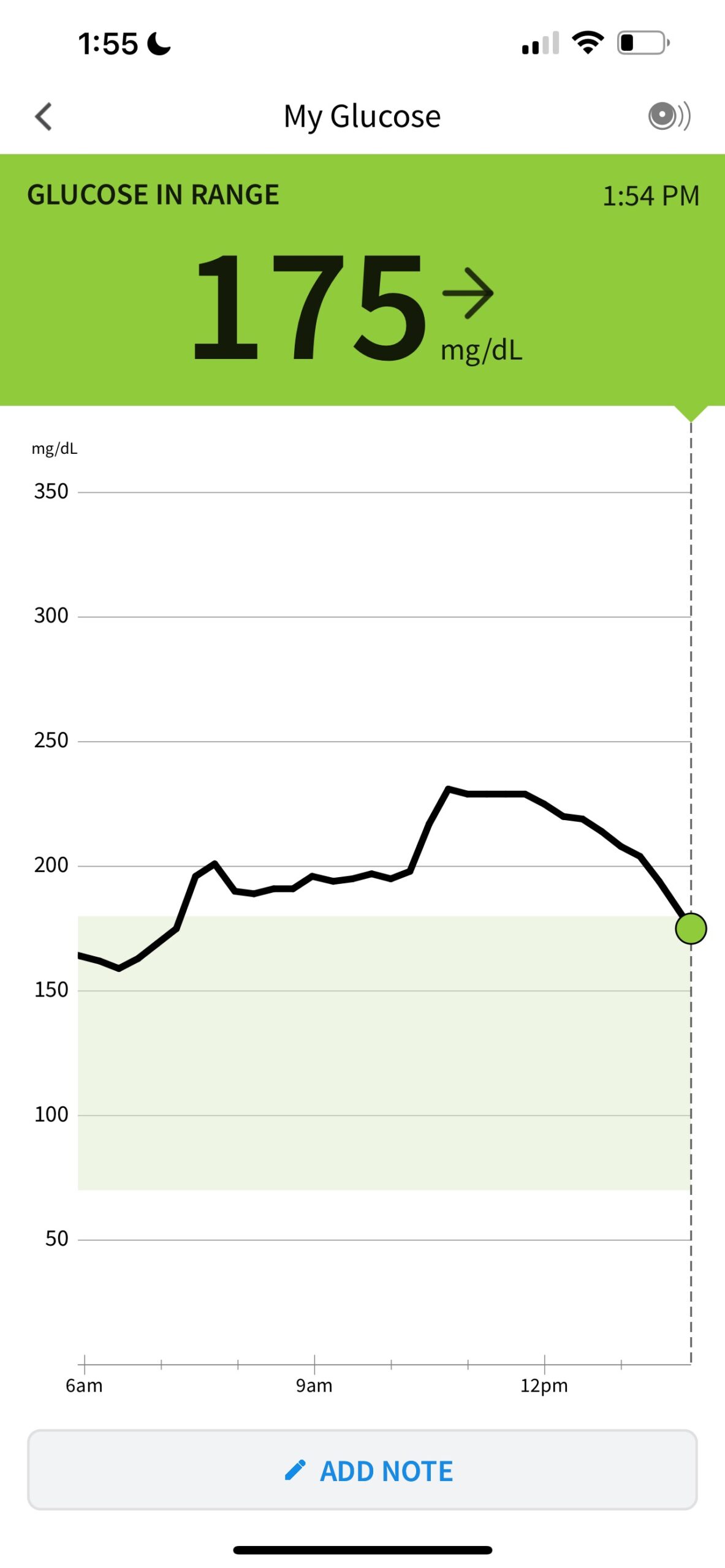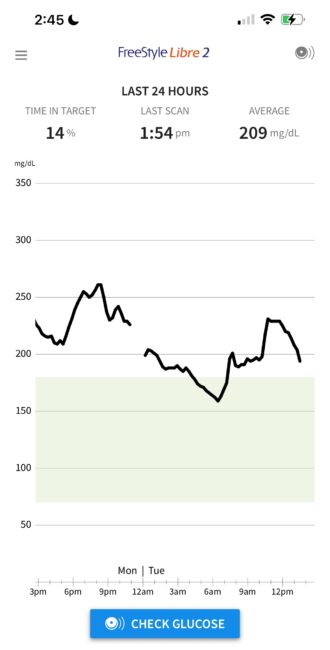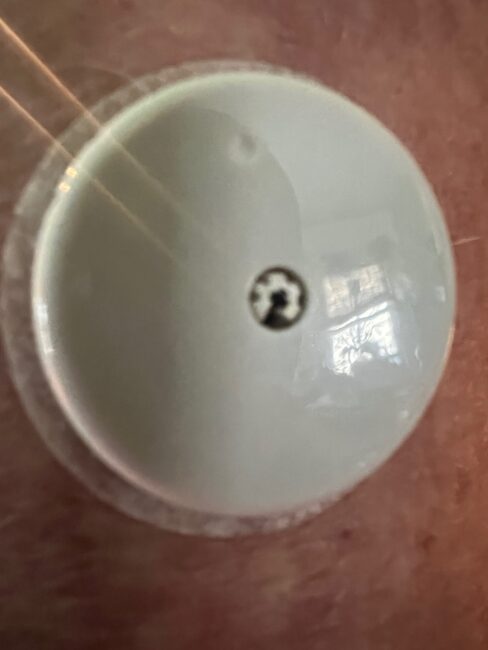It’s my healthcare story of the year, perhaps the most serious since my Open Heart Surgery in 2014.
About three months ago, Covid finally reached Maria and me on the same day.
She recovered quickly; it took me longer. And the virus almost instantly doubled and tripled my hard-fought and low blood sugar levels.
There are many kinds of Covid and different ways to be affected by it.
My Covid hit me hard, especially when it came to diabetes. I was always a bullseye for the pandemic. I’m 75 with heart disease and diabetes, the combination that has killed so many people worldwide and came close to killing me.
I am lucky to be alive. If not for doctors and scientists and vaccines, I wouldn’t be.
I didn’t get the mild version; I got the mean one.
I was short of breath; my joints were on fire; I started gaining weight, feeling dizzy, and suffering from nausea and vomiting for weeks. Because I was vaccinated and bosted, my doctors said, I held my own. Covid struck almost every part of my body.
But there were plenty of side effects, most of them are gone now, but some remain.
Almost everyone has gotten it, and I didn’t want it to be the focus of my life and work, even though it was just that. So I didn’t write about it. I didn’t want my health to define me, and it never kept me from writing on my blog or taking pictures.
One of the most severe effects of the virus on me was its effect on my blood sugar, which instantly doubled. It was a setback.
I’ve proudly and tightly controlled my diabetes for years now.
According to the Mayo Clinic, a blood sugar level of 200 or higher is a clear symptom of diabetes.
An A1C of seven or higher is a warning sign for stroke and heart trouble. I always kept my blood sugar well under 200, mostly below 100. My doctors were pleased; they told me I was a great diabetes patient. My A1C was six or seven, sometimes higher, but typical of men my age with my chronic illnesses.
I paid close attention to what I ate and how much, and I lost 15 pounds last year before Covid came. Most of it came back quickly, and I could not lower it.
Covid floored me for weeks. My blood sugar was in the high 200s and sometimes up to 300. My A1c shot up to eight.
As recently as two weeks ago, my blog sugar hit a lifetime high of 350 one night, the highest it has ever been. I was frightened and discouraged. Nothing I did caused me to lose weight or lower my number. My blood sugar no longer seemed anything I could alter or control.
I saw Amy Ethridge, my primary care nurse, and my diabetes counselor.
I told her I was afraid I had reached a point where my diabetes could not be controlled. The Covid was just too strong. It was hard to keep my morale up; I couldn’t see a way out of it. And I was too easily tired.
Nothing I did could bring that number down.
Amy is resourceful and very encouraging. She was unflappable, and we came up with a new plan.
She told me I could handle it; I had done it for years.
She changed my insulin, altered the dose, prescribed a new bi-weekly monthly home injection for me, reviewed my diet with Maria and me, and waited eagerly for my new orthotic so I could walk every day again.
I was doubtful, and I was stumped, I told her.
No matter what I did, the high numbers wouldn’t change.
And I felt I was running out of time. You don’t want to see numbers like that daily at my age or with my health issues.
I thought I had dodged Covid, but now I wasn’t sure.
Amy came up with another idea. There is a radical new testing system called Libre 2.
You stick a self-attaching button onto the back of your lower arm, where it stays for two weeks (I have more in reserve). It stays on by itself and needs to be replaced every two weeks.
You don’t need to stick yourself with pin-prick needles and draw blood any longer.
I just point the front of your Iphone at the top of the button, and it instantly transmits your blood sugar to the Libre 2 App, which is now displayed in the Libre App. I can see it anytime you wish.
It’s a remarkable thing to see and the simplest thing to do. No more finger pricks, test strips, or meters. Another big score for the Iphone.
The Libre2 shows my numbers. Green and blue are good, but red is not.
At its worst, I felt exhausted, although I never tired of writing or taking pictures. My body seemed to leave me behind. I worked early in the morning and late at night when my energy and focus seemed strong.
Amy understood that part of my problem was my Dyslexia, and part of it was how I think and process information. I’ve never mastered the intimate and intricate connection between what I ate and how it affected my diabetes. Generally, I ate very well in terms of health. I never ate meat or fried and processed foods.
But something I told her was off. It turns out that something was me, I couldn’t blame it all on Covid.
She reasoned – Maria agreed – that the new Libre 2 system could change the dynamic. First, I love instant gratification and new technologies because they are often calm and easy to use.
Secondly, because I was testing my blood only once a day, I didn’t know how all the foods I ate affected my blood sugar. I knew what I read on labels and soon realized that many were inaccurate. We Americans are gullible label readers.
We always assume corporations can’t get away with lying. But that was before corporate billionaires controlled politics and spent billions of dollars lobbying government agencies and people in Congress.
With the Libre 2 device, I test myself eight or nine times a day. I can know instantly how I react to food or movement.
I don’t want to sound like a commercial, but Litre 2 is easy, painless, and bloodless; most insurance covers it.
I get to look at a nifty chart that marks my blood sugar level (see graphics) before and after eating.
For the first time, I could see precisely what my favorite wheat-basted and organic pasta from Italy does to my blood sugar as opposed to a piece of fish or a salad or vegetables.
Intellectually, I knew all this, but the Libre changed how I understood my diabetes and how my blood sugar responds.
I didn’t depend on the once-a-day testing to tell me how I was doing. I had to learn this hour by hour, which is working for me.
Last week, I had the highest blood sugar count ever and was worried. Yesterday and today, it plunged rapidly, almost back to normal. I am under 200 now, sometimes under one hundred.
At this rate, I’ll be back to the pre-Covid level in a few days. I’m eating differently, thinking differently, and learning differently. This new approach leaps right over my Dyslexia and confusion and rubs my face with what I eat, how much I eat, and when I eat. No more guessing or dodging.
Amy knew it would motivate me if I tried Libre 2.
I am almost there, and I shake my head in wonder every time I point my Iphone at this button on my arm and get an instant blood sugar reading. I’ve altered a lot of my diet, much of which I thought and was told was healthy for me.
The books and nutrition guides are often wrong or incomplete.
Next to my heart surgery, I believe this was the most critical healthcare challenge of my life. Once again, I can thank a caring and skilled healthcare worker who guided me along with a supportive and loving partner. Once again, I learned to never give up on myself and take responsibility for my life and health.
You might think I should know this by now, but I am all too human and distractable. I don’t often think long-term or absorb information the way I would like. Amy says I am one of those who sometimes need a kick in the butt to pay attention.
But I am breathing more efficiently and more determined than ever.
I can learn something from anything, especially trouble, and difficulty.
My strength and focus have returned. I took my longest walk in months this afternoon.
I feel strong and clear.
Life is full of these moments; there will be more. I am not the producer of my own life.
Between them, I will practice joy, try to do good, and give thanks for another chance to get my whole life back.




What fantastic news, really.
And the walk that must have felt liberating.
Thank you for sharing I am sharing this with a friend whose son has diabetes since he was 12 he is 21 now.
Wow, interesting! Thank you for sharing.
Enjoy using the Libre it will help make your life a little easier .I am 65 years old and been type 1 diabetic since a teen ager so I know how painful finger testing can be. I have tried many different continuous glucose meters . I wear an insulin pump and a guardian 3 sensor . It is a life saver to at any point just look at my phone and see my blood sugar reading . Also gives a warning if heading to low or to high . Thanks for sharing it’s nice to see other people share their experiences with this disease. Thanks for sharing and opening up about your personal health.
Yes, this technology is wonderful for us. Who knew, right? I have been wearing the Libre2 since last summer and I’d be lost without it. Alarms on your phone can go off during the night if glucose is too low or too high. I also use an “Inpen” for short acting insulin and that too has a phone app. It calculates what insulin is already ‘on board” and you enter how many carb grams you are about to eat and it calculates how much insulin you need. With the sensor and the Inpen you can see what your numbers are after a meal and how much estimated insulin is still digesting that meal. Fabulous. Your doctor sets up the parameters for the Inpen. The best part is that you know how much insulin you took and what time the last dose was. This tends to be a problem for me and I know you’ve mentioned in the past that sometimes we forget if we took the insulin dose. If you’re lucky, your health insurance will cover most of the cost of the Inpen. The pen itself lasts one year and takes insulin cartridges. If you find the sensor irritates your skin underneath, there is a great company that makes a woven underlay that is very comfortable.
I understand the focus problem. I have a “little sugar problem” too and when I was decades younger I was in a shopping mall leaning up against a wall and could not remember my name. I’m sure people thought I was drunk.
As a fellow type 2 diabetic, I’ve used several brands of stick on CGM’s. I don’t care for them for many reasons. They are helpful in teaching us the effects of food on our bodies though. I worked with a wonderful diabetes educator who helped me the most. I switched my diet up and, like you, I started losing weight. I take long acting insulin at bedtime. For some reason every nurse told me to use a high amount of it. It wasn’t until last year when I saw an actual Endocrinologist that the dosage was dropped. Ever since then I’ve been losing weight 😊. I was always told all of the standard things exercise and watch what I eat and they never worked because of the high insulin dosage. I’m very thankful for my Endocrinologist and diabetes educator as they’ve helped me so much.
I’m very glad that Amy found a way to help you 😃.
What an adventure! Libre 2 sounds like a real breakthrough. I will keep this in mind for the people in my life. Congratulations on this deep mindful awareness of testing and diet, and their connection.
I don’t do insulin so Libre2 said our insurer does not cover it. Seems like it would be good to know tho’.
Thanks for the great write up.
I’m surprised how little diabetics often know about the disease and its gradations.
Awesome tech! I don’t think I would be the only person interested in seeing some before and after readings for some of the foods you eat. (And yes, everyone is different but it would be very interesting.) Does regular pasta raise it more than wheat/whole grain? If you use Splenda or other sweeteners, do they raise it? How about pizza?
One interesting thing I have read is that if you use fat (like olive oil) in something that is normally high GI – like pasta, it will often not trigger as big of a spike.
Anyway, I’d be interested in hearing more about how the Libre is helping you. I’m probably not too far away from needing one myself.